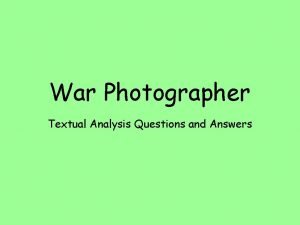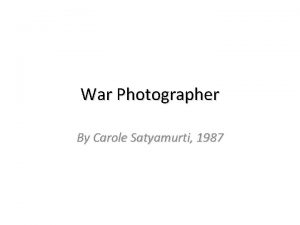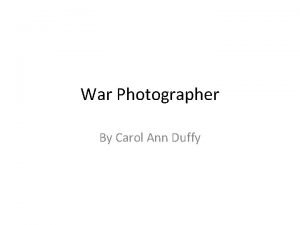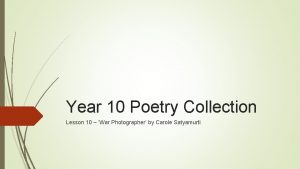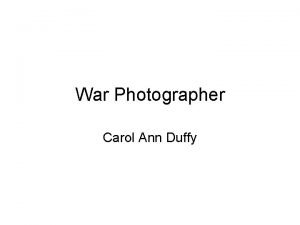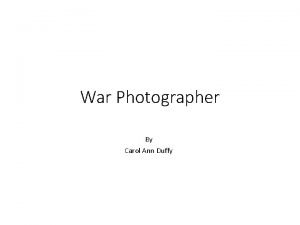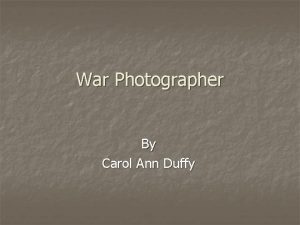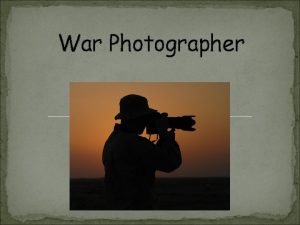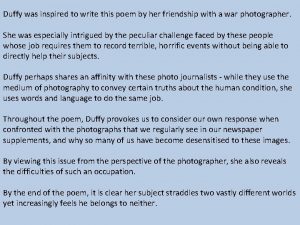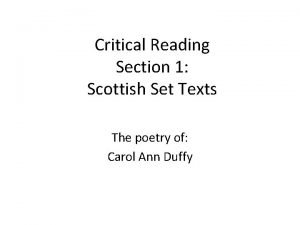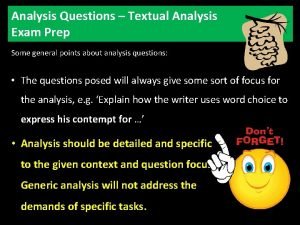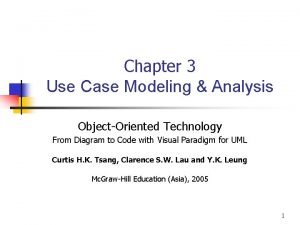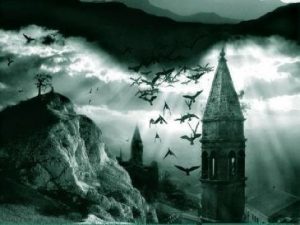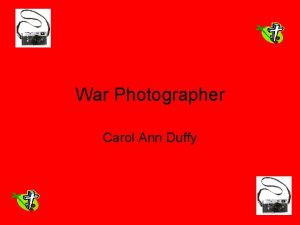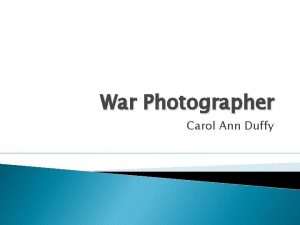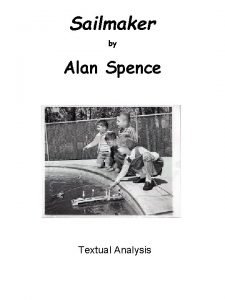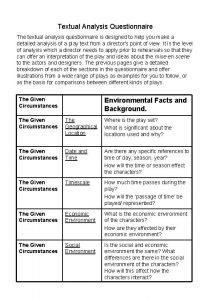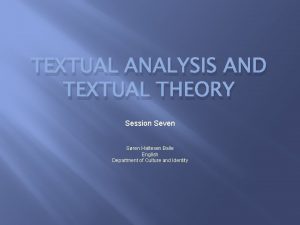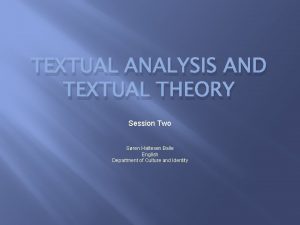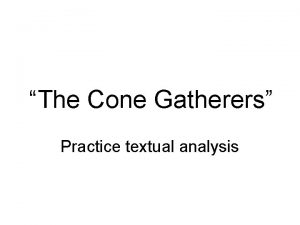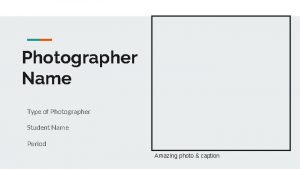War Photographer Textual Analysis Questions and Answers 1



















- Slides: 19

War Photographer Textual Analysis Questions and Answers

1. How is the poem structured and how does this contrast with the images described in the poem? (2) • Orderly, rigid structure. (1 mark) • Contrast with chaotic images in poem. (1 mark)

Q 1. Example answer The poem is in 4 stanzas with each stanza comprising of 6 lines of a fairly equal length. The images described in the poem are chaotic and are out of the war photographer’s control. This contrasts with the rigid, ordered structure of the poem which is written as if the photographer is trying to enforce normality on his life.

2. Why has Duffy compared the war photographer to a Priest in the first stanza? (2) • Seriousness of the job • Caries it out religiously • Sense of duty • Dedicated/a calling

Q 2. Example answer The photographer is described as a priest because he develops photos with the same sense of importance and duty as a priest would when in church. It highlights the respect the photographer holds for his job.

3. What effect is created by the sentence structure used in line 6? (1) • One word sentences of countries affected OR short sentence for Biblical reference. • Gives each place importance • Serves as bleak acceptance that all must die.

Q 3. Example answer The one word sentences place emphasis on each of the war zones. It shows the importance of each place and emphasises that the war photographer will never forget them. The list also highlights just how many places were devastated by war.

4. What is ambiguous about the word ‘Solutions’ in line 7? (1) • The chemicals used to develop photos. • The pictures could serve as a way to end the conflict.

Q 4. Example answer The word ‘solutions’ is ambiguous as it could mean the chemicals used to develop the pictures or the fact that his photography is used to try and resolve conflict and educate people, acting as a solution to the violence.

5. Comment on Duffy’s use of contrast in the second stanza. (2) • “ordinary pain” and ‘exploding fields” • “simple weather can dispel” and “exploding fields” • “Rural England” and “exploding fields” • “ordinary pain” and “children running in a nightmare heat”

Q 5. Example answer The contrast in stanza two highlights how insignificant our problems are in comparison to the inhabitants of dangerous war zones. Where Britain is described as “Rural” with positive connotations of rolling hills and rivers, this cosy vibe is replaced with a sense of danger, in that overseas, the countryside can literally “explode beneath the feet. ” Our arbitrary problems are shown as worthless in comparison to the daily threat of death surrounding civilians in war zones.

6. Comment on the effectiveness of the word ‘stained’ in line 18. (2) • Connotations of permanence. • Idea that these atrocities will not be forgotten. • Forever a mark on the countries history. • Photographer can never escape the memories.

Q 6. Example answer The word “stained” has connotations of ruin and permanence. The photographer suggests that the sight of death will not only remain with him forever but will be a mark on the country's history. The victims of war should be remembered.

7. Fully comment (quotes and explanation) on the use of contrast in the final stanza. (4) • “A hundred agonies” and “pick 5 or 6” - idea of only getting a small portion of the conflict • “A hundred agonies” and “between bath and prelunch beers” - idea of contrast between their suffering and our luxuries. • “prick with tears” and “they do not care” - idea of them being upset one minute but shortly after losing all concern.

Q 7. Example answer Duffy creates contrast in the final stanza. “A hundred agonies” congrats with “five or six”. This shows that although there are so many people dead and the photographer has taken so many pictures, only a few will be shown to the public, meaning we don’t get a clear idea of the scale of conflict. “A hundred agonies” also contrasts with “between bath and pre-lunch beers”. This shows the difference between our world and theirs as they are suffering and dying whereas we are enjoying luxuries. “readers’ eyeballs prick with tears” contrasts with “they do not care”. This shows that although the photographer has taken these horrific pictures, the public’s “eyeballs prick” meaning they are only briefly affected by it and then they forget. They are only affected by it because they think they have to be seen to be in the eyes of others.

8. How effectively does Duffy use language features to confront the reader with the horrors of war? (4) • “spools of suffering” - sibilance/alliteration - highlights scale of the war • “All flesh is grass. ” - short sentence - Biblical reference - grim thought • “tremble” - connotations of weakness, vulnerability - highlight PTSD state of photographer • “nightmare” - connotations of bad dream, terror • “children” - connotations of innocence • “twist” - connotations of contortion, pain • “half-formed ghost” - imagery - idea of being haunted, life leaving • “cries” - connotations of severe distress, enjambment suggests everlasting sound • “agonies” - connotations of extreme pain • Short sentences “He has a job to do” and “Something is happening” - highlight the fact that he cannot escape these horrors as he feels the need to be seen and heard

Q 8. Example answer “agonies” has connotations of extreme suffering and pain. It emphasises the horrors of the war and the suffering many people face. It shows a clearly distressing image of hundreds dying. “nightmare” has connotations of terror, fear and dreams. It is effective in emphasising the horror of the war because it suggests that the suffering is so unimaginable for those in Britain that it is almost like a bad dream. “cries” has connotations of distress and grief. It is effective in emphasising the horrors of the war because it highlights the misery and pain those in war zones suffer from.

9. How effective are the final lines of the poem in helping the reader to understand Duffy’s message? (2) • “they do not care” - theme of apathy • “he stares impassively” - photographer’s sad acceptance that the situation will not change ending on a pessimistic note

Q 9. Example answer The final two lines are effective in rounding off the poem as they comment on the apathetic nature of us towards the war photographs. The effective repetition of the “A” sound in “From the aeroplane he stare impassively” shows a sense of monotony in the desensitised mind of the war photographer who faces death every day and is met with an audience who hardly care. Duffy’s message on apathy and our tendency to do so little to help one another is incarnated here in the defeated vision of the man behind the camera.
 War photographer comprehension questions
War photographer comprehension questions War photographer carole satyamurti
War photographer carole satyamurti A hundred agonies in black and white
A hundred agonies in black and white War photographer lesson
War photographer lesson Half formed ghost
Half formed ghost Rhyme in war photographer
Rhyme in war photographer War photographer theme
War photographer theme Solutions slop in trays
Solutions slop in trays What inspired carol ann duffy
What inspired carol ann duffy What inspired carol ann duffy to write war photographer
What inspired carol ann duffy to write war photographer Textual analysis questions
Textual analysis questions In your notebook change
In your notebook change Toward civil war lesson 3 secession and war
Toward civil war lesson 3 secession and war What are use cases
What are use cases The cask of amontillado answers to questions
The cask of amontillado answers to questions War at home vs war abroad madison
War at home vs war abroad madison Korean war vietnam war venn diagram
Korean war vietnam war venn diagram The cold war begins lesson 1
The cold war begins lesson 1 Reconstruction venn diagram
Reconstruction venn diagram Was josette dugas pro war
Was josette dugas pro war
